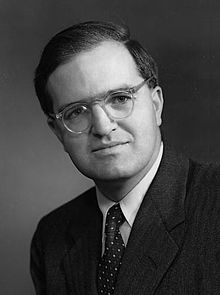
Back آجي بور Arabic آجى بور ARZ आजे नील्स बोर AWA آگه بوهر AZB Оге Нільс Бор BE Оге Нилс Бор Bulgarian অউ নিলস বোর Bengali/Bangla Aage Niels Bohr Catalan Aage Niels Bohr Czech Aage Bohr Danish
Aage Bohr | |
|---|---|
 Bohr in 1955 | |
| Born | 19 June 1922 Copenhagen, Denmark |
| Died | 8 September 2009 (aged 87) Copenhagen, Denmark |
| Alma mater | University of Copenhagen |
| Known for | Geometry of atomic nuclei |
| Parent(s) | Niels Bohr (father) Margrethe Nørlund (mother) |
| Awards |
|
| Scientific career | |
| Fields | Nuclear physics |
| Institutions | |
| Thesis | Rotational States of Atomic Nuclei (1954) |
Aage Niels Bohr (Danish: [ˈɔːwə ˈne̝ls ˈpoɐ̯ˀ] ⓘ; 19 June 1922 – 8 September 2009) was a Danish nuclear physicist who shared the Nobel Prize in Physics in 1975 with Ben Roy Mottelson and James Rainwater "for the discovery of the connection between collective motion and particle motion in atomic nuclei and the development of the theory of the structure of the atomic nucleus based on this connection".[1] His father was Niels Bohr.
Starting from Rainwater's concept of an irregular-shaped liquid drop model of the nucleus, Bohr and Mottelson developed a detailed theory that was in close agreement with experiments.
Since his father, Niels Bohr, had won the prize in 1922, he and his father are one of the six pairs of fathers and sons who have both won the Nobel Prize and one of the four pairs who have both won the Nobel Prize in Physics.[2][3]
- ^ "The Nobel Prize in Physics 1975". The Nobel Foundation. Retrieved 12 May 2015.
- ^ "Nobel Prize FAQ". The Nobel Foundation. Archived from the original on 22 December 2015. Retrieved 22 February 2020.
- ^ "Facts on the Nobel Prize in Physics". The Nobel Foundation. Retrieved 22 February 2020.